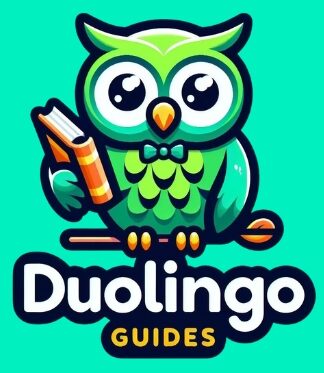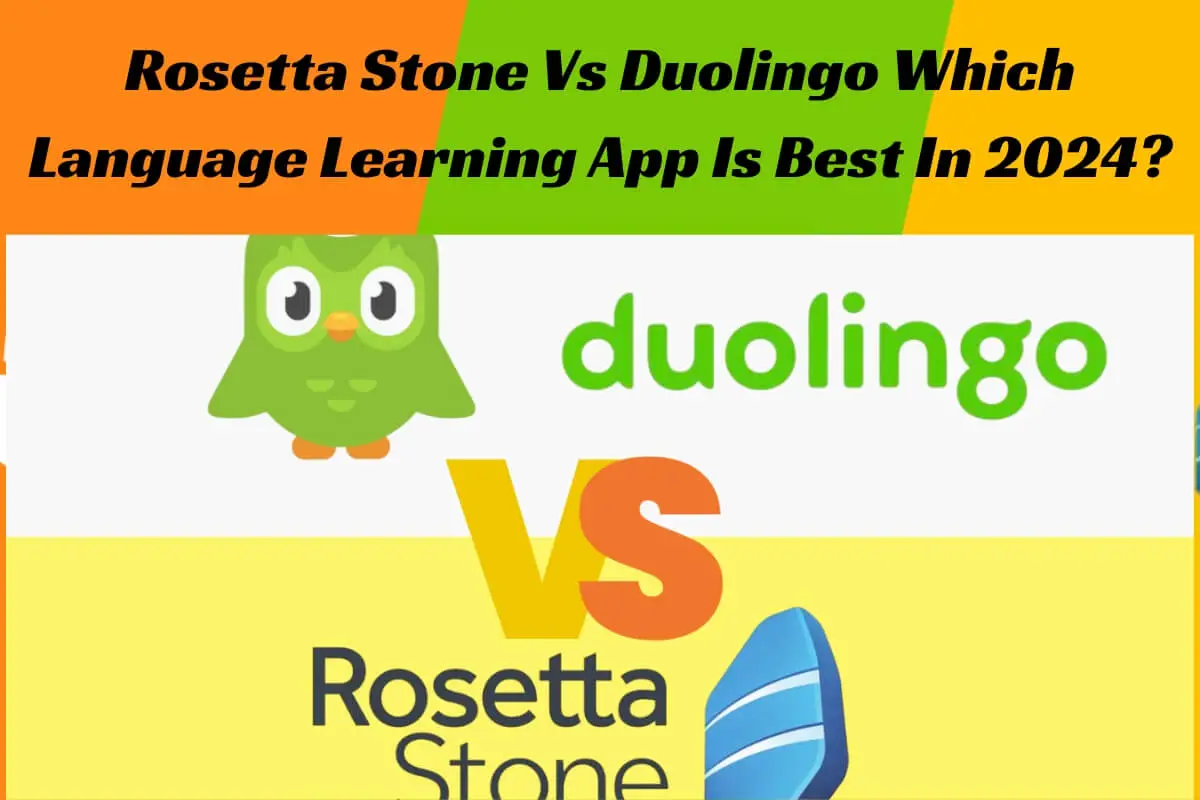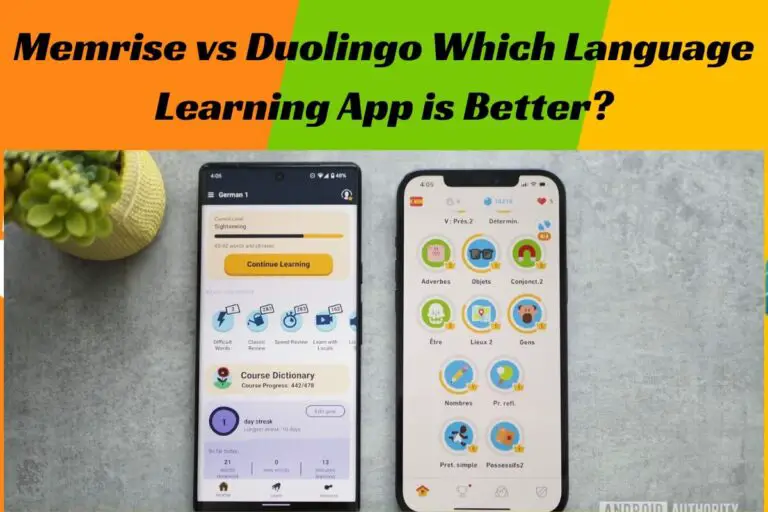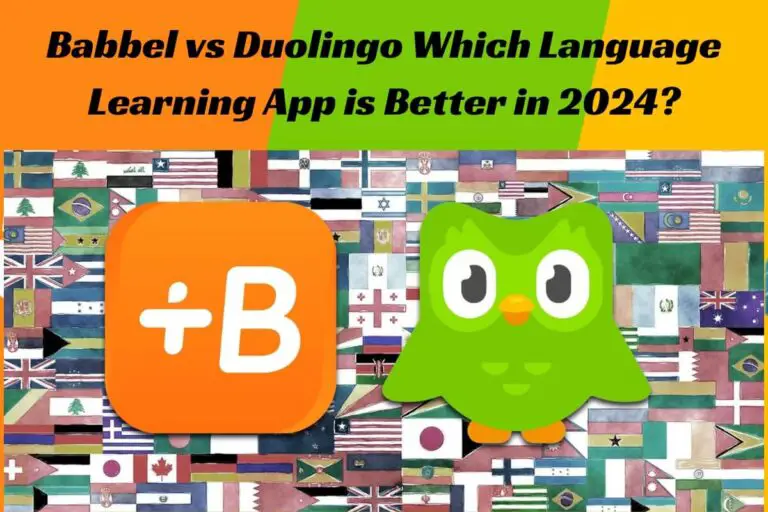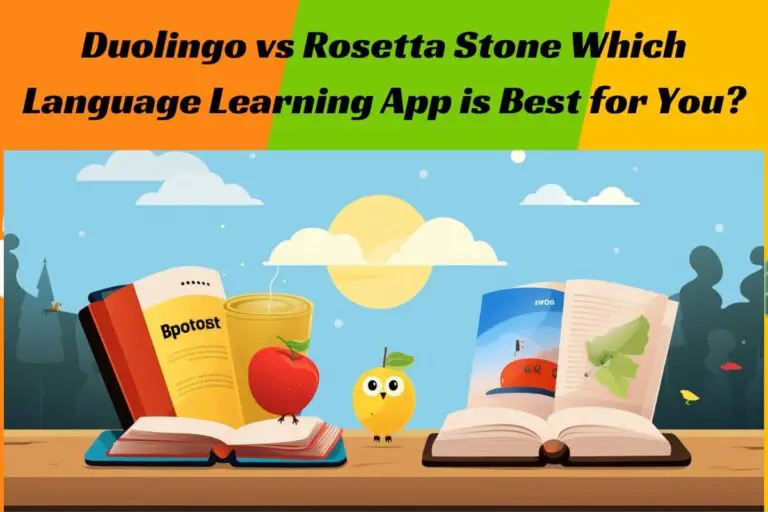Are you trying to decide between Rosetta Stone and Duolingo for learning a new language? Both are popular apps, but they have some key differences.
In this guide, we’ll do a thorough comparison of Rosetta Stone vs Duolingo. We’ll look at their teaching methods, lesson structure, speech recognition, pricing, user experience, and more.
By the end, you’ll know which app is better suited for your language goals and learning style. Let’s dive in!
What is Rosetta Stone?
Rosetta Stone has been around since 1992. It’s one of the pioneers of modern language learning apps and courses.
The company is known for its “Dynamic Immersion” teaching method. This method focuses on learning languages the way you learned your native tongue as a child – through visuals, audio cues, and full immersion.
With Rosetta Stone, you match words and phrases to images and real-life scenarios. There’s no translation or hand-holding. You’re fully immersed in the new language from day one.
This visual, intuitive approach helps your brain make connections and learn more naturally. Over time, Rosetta Stone’s progressive curriculum builds up your skills in reading, writing, speaking, and comprehension.
Some key features of Rosetta Stone include:
TruAccent Speech Recognition This proprietary technology listens and provides feedback as you speak. It helps improve your pronunciation and accent.
Structured Lessons with Reviews Lessons follow a logical progression from simple to complex topics. You’ll regularly review previous concepts to reinforce learning.
Language Options You can learn over 25 different languages with Rosetta Stone. These include Spanish, French, Italian, German, and more.
While Rosetta Stone has mobile apps, many learners prefer the desktop software program for its robust features.
What is Duolingo?
Compared to Rosetta Stone’s long history, Duolingo is the new kid on the block. This language-learning app was launched in 2011.
From the start, Duolingo took a different, more modern approach to teaching languages. The app embraces gamification to make learning fun and addictive.
With Duolingo, you complete bite-sized lessons filled with interactive exercises and mini-games. For example:
- Translating phrases from English to your target language
- Selecting the proper translation for words or sentences you hear
- Speaking phrases aloud using speech recognition
- Arranging scrambled words to form grammatically correct sentences
As you get the exercises right, you earn points and virtual rewards. This gamification makes lessons feel more like playing a mobile game than studying.
Duolingo also incorporates other game-like features:
- Daily rewards for keeping a streak alive by practicing daily
- Experience points and level progression
- Leaderboards for competing against other users
- Zany characters and a mascot that cheers you on
In recent years, Duolingo has expanded with new learning tools like podcasts, interactive comics, and audio lessons. But at its core, it’s still all about those bite-sized, gamified language lessons.
Duolingo currently offers courses in 40+ different languages. This includes less common options like Hawaiian, Navajo, Esperanto, and High Valyrian from Game of Thrones.
Rosetta Stone vs Duolingo: Teaching Methods
The biggest difference between Rosetta Stone and Duolingo is their underlying teaching methodology.
As mentioned, Rosetta Stone emphasizes full language immersion. You spend your entire time listening, speaking, reading, and writing in your new language.
There’s no translation or English instructions allowed. Rosetta Stone gives you visual and audio cues and you have to figure out the meanings through context and inference.
This immersive approach is designed to replicate how you naturally acquired your native language as a child through full exposure.
In contrast, Duolingo takes a more traditional route of explicit instruction with plenty of translation between languages. The interactive exercises walk you through the language with helpful hints in English.
So which teaching method is better? That depends on your learning style and preferences.
The immersive nature of Rosetta Stone can be extremely effective as long as you’re comfortable learning through context clues. But it requires more patience and active mental processing.
Duolingo’s translate-and-practice approach may feel more familiar to adult learners. However, you don’t get as much natural language exposure.
Lesson Structure and Content
To give you a clearer picture, let’s compare how actual lessons are structured in each app.
With Rosetta Stone, a single lesson unit is 30 minutes long. But you can break it into three 10-minute sessions if needed. The entirety of your lesson time is spent:
- Matching words, phrases, and sentences to images
- Listening to audio recordings and repeating out loud
- Doing pronunciation exercises for individual syllables
Rosetta’s lessons methodically build up your vocabulary and comprehension skills. They start simple with basic nouns and phrases. Eventually, you’ll work up to longer sentences and tackle more grammar concepts.
In contrast, Duolingo breaks its content down into much shorter, bite-sized lessons. We’re talking perhaps 5 to 10 minutes max.
Each lesson focuses on introducing a few new words and phrases through various mini-exercises and games. For example, in one lesson you might:
- Type out translations for vocabulary terms
- Rearrange jumbled words to form a grammatically correct sentence
- Repeat spoken phrases aloud to practice pronunciation
The variety of quick activities in Duolingo’s “game-ified” lessons is meant to keep you engaged and having fun while learning.
One major difference is that Duolingo tends to lean more heavily on direct instruction, translation between languages, and explicit grammar explanations.
Rosetta Stone, on the other hand, skips over overt grammar lessons in favor of implicitly picking things up through immersion and repeated exposure.
Speech Recognition and Pronunciation
As you’d expect from their contrasting methodologies, Rosetta Stone and Duolingo take different approaches to improving your pronunciation and speaking abilities.
Rosetta Stone has its proprietary TruAccent speech recognition technology. This uses complex algorithms to listen, analyze, and provide feedback on your speech.
During speaking exercises, TruAccent will let you know if you pronounced a word or syllable incorrectly. It offers guidance on how to properly form sounds in the new language.
From plenty of experience and testing, I can confirm that TruAccent’s recognition is impressively accurate. It picks up on subtle nuances missed by other programs.
This speech recognition tool combined with Rosetta Stone’s pronunciation drills is a powerful way to improve your accent and spoken skills.
Duolingo also incorporates speech recognition exercises. But its technology doesn’t appear to be as advanced as TruAccent.
With Duolingo’s speaking activities, you’ll repeat words and phrases aloud. If the app detects you’re off, you may get a prompt to try again. But the feedback is very surface level without detailed pronunciation advice.
Duolingo’s approach seems more focused on just getting you comfortable speaking out loud versus hardcore accent training.
Keep in mind, that neither of these apps can truly replace the feedback of a real human tutor. But Rosetta Stone currently has the edge for pronunciation work.
Pricing and Value for Money
Now, let’s look at pricing because cost is often a deciding factor with apps and subscriptions.
The biggest draw of Duolingo is that you can access it 100% free with no subscription required. You’ll have to deal with ads and other minor limitations, but there’s no paywall.
If you want to go ad-free with offline access and other extras, Duolingo offers:
- Monthly subscription: $12.99 per month
- Annual subscription: $84 per year
In contrast, Rosetta Stone uses a premium subscription model with no free version. They offer a free 3-day trial and a 30-day money-back guarantee to test the program.
For accessing Rosetta Stone’s desktop software or mobile apps, you have two subscription options:
- 3-month access to a single language: About $15.99 per month ($47.97 total)
- 12-month access to all 25 languages: $13.99 per month ($167.88 total)
Rosetta also sells lifetime access for a one-time fee of $399, though this is occasionally discounted.
Duolingo is the cheaper and more accessible option. But you could make the argument that Rosetta Stone provides more overall value if you take advantage of all its features and resources.
It depends on your budget and how seriously you want to learn. If you’re on a tight budget or just want to casually pick up the basics of a language, Duolingo’s free version is hard to beat. But for more comprehensive learning, Rosetta Stone offers additional value if you invest in a paid subscription.
User Experience and Interface
Another big factor that separates these two apps is their overall user experience and interface design.
Rosetta Stone has a clean, minimalist interface that’s easy to navigate. The lessons follow a logical progression laid out in a simple format. While not overly exciting visually, Rosetta Stone’s interface gets the job done without distractions.
In contrast, Duolingo has a much more vibrant and game-like user experience. The app is filled with bright colors, quirky characters, and fun animations. Lessons are presented almost like levels in a video game.
This super engaging design makes Duolingo feel less like you’re studiously learning and more like you’re playing an addictive mobile game. The gamified experience is a large part of why Duolingo can keep users coming back daily.
Both apps incorporate elements of personalization and progress tracking. But Duolingo leans into this harder with leaderboards, rewards, customizable profiles and more.
In the end, Rosetta Stone has a more traditional, streamlined user experience focused on efficient learning. While Duolingo injects plenty of pizazz and game-like elements to make studying feel more entertaining.
Progress Tracking and Learning Resources
Speaking of progress tracking, let’s look at how each app monitors your advancement and mastery of skills.
With Rosetta Stone, you’ll complete lessons that build progressively on one another. After each lesson, you get a score based on your performance in areas like pronunciation, vocabulary, and grammar.
If you don’t master a lesson, Rosetta Stone will automatically schedule review sessions to reinforce those shaky concepts before moving on. This “learns while you learn” approach keeps you focused on weak areas.
Duolingo takes a slightly different approach to progress tracking and review. Rather than linear lessons, you’ll complete bite-sized skills spread across a larger curriculum.
Duolingo’s algorithms track your strengths and weaknesses, providing extra practice in areas where you need improvement until you master them.
Both apps also provide supplemental resources to reinforce your core lessons. With Rosetta Stone, you get access to:
- Pronunciation tutors and TruAccent speech analysis
- Digital phrasebooks and reference materials
- Audio stories and comprehension activities
- Mobile apps for practicing anywhere
Duolingo extends learning through features like:
- Podcasts for listening practice
- Interactive comic strips for reading comprehension
- Audio lessons from real native speakers
- Language learning communities and clubs
Rosetta Stone focuses on its core curriculum, while Duolingo offers more diverse and multimedia content.
Which App is Better for Different Language Levels?
At the end of the day, the Rosetta Stone vs Duolingo debate comes down to your current language level and specific learning goals. Each app caters to certain proficiency levels better than others.
Best for Beginners
If you’re an absolute beginner with zero previous exposure to a language, you’ll probably have an easier time starting with Duolingo.
Its gamified lessons that ease you in with simple vocabulary and translation make for a gentle introduction. The bite-sized format is also perfect for novice learners with short attention spans.
Rosetta Stone’s full immersion approach can prove overwhelming for true beginners. Having zero context to start can make you feel lost and frustrated.
Best for Intermediate Learners
Once you have a decent beginner foundation in a language, that’s when Rosetta Stone starts to shine. Its structured immersion program is extremely effective if you already know basic words and grammar.
Intermediate learners are at the perfect stage to take advantage of Rosetta Stone’s contextual learning and pronunciation training. You’ll build practical conversational skills quickly.
Duolingo can still provide supplemental practice at this level. But its curriculum starts feeling too basic and simplistic once you move beyond the earlier skills.
Best for Advanced Learners
For those pursuing advanced fluency and mastery, Rosetta Stone’s depth becomes more limited. Its immersion lessons simply don’t offer enough complex grammar, contextual training, and other high-level content.
The same goes for Duolingo. While Duolingo can get you to a conversational level for travel, its curriculum isn’t robust enough for advanced learners looking to truly master a language.
At this stage, supplementing with other advanced resources like private tutors, conversation practice, literature, and media consumption becomes essential.
Conclusion
Phew! We’ve covered a ton of ground comparing Rosetta Stone vs Duolingo. Both are fantastic resources, but they take fundamentally different approaches to language acquisition.
Rosetta Stone stays true to its roots with an immersive, visual method designed to teach languages more intuitively like your native tongue. The progressive curriculum combined with speech analysis tools makes it powerful for improving accent and conversational abilities.
Duolingo embraces more modern gamification and bite-sized lessons heavy on translation exercises. Its addictive mobile-first experience excels at getting beginners hooked and consistently practicing through a fun, casual approach.
Choose between Rosetta Stone and Duolingo based on your learning style, goals, budget, and skill level. Both are good options, but one will suit you better.
And of course, don’t forget that the most effective language learning combines multiple resources, consistent practice, and fully immersing yourself in the language as much as possible.
Hopefully, this guide provided all the context you need to decide if Rosetta Stone or Duolingo is the ideal language app to start your journey. The most important thing is that you find an approach that keeps you motivated and engaged as you embark on mastering a new language.
